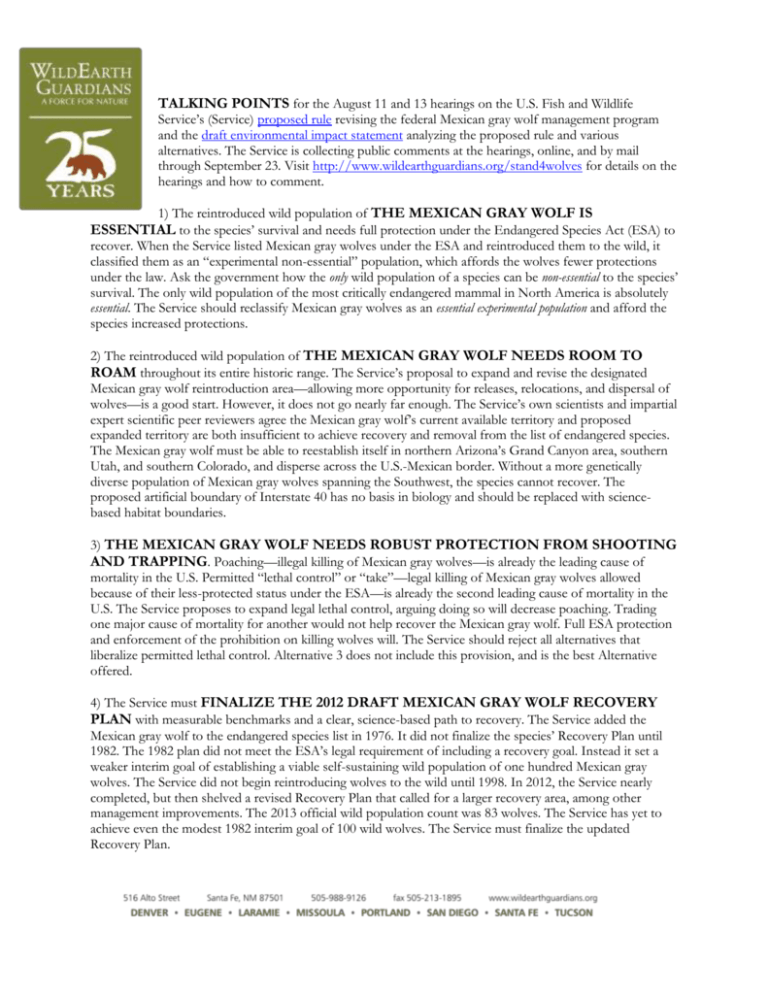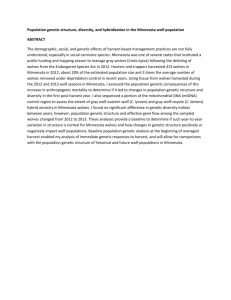TALKING POINTS for the August 11 and 13 hearings on the U.S.
advertisement

TALKING POINTS for the August 11 and 13 hearings on the U.S. Fish and Wildlife Service’s (Service) proposed rule revising the federal Mexican gray wolf management program and the draft environmental impact statement analyzing the proposed rule and various alternatives. The Service is collecting public comments at the hearings, online, and by mail through September 23. Visit http://www.wildearthguardians.org/stand4wolves for details on the hearings and how to comment. 1) The reintroduced wild population of THE MEXICAN GRAY WOLF IS ESSENTIAL to the species’ survival and needs full protection under the Endangered Species Act (ESA) to recover. When the Service listed Mexican gray wolves under the ESA and reintroduced them to the wild, it classified them as an “experimental non-essential” population, which affords the wolves fewer protections under the law. Ask the government how the only wild population of a species can be non-essential to the species’ survival. The only wild population of the most critically endangered mammal in North America is absolutely essential. The Service should reclassify Mexican gray wolves as an essential experimental population and afford the species increased protections. 2) The reintroduced wild population of THE MEXICAN GRAY WOLF NEEDS ROOM TO ROAM throughout its entire historic range. The Service’s proposal to expand and revise the designated Mexican gray wolf reintroduction area—allowing more opportunity for releases, relocations, and dispersal of wolves—is a good start. However, it does not go nearly far enough. The Service’s own scientists and impartial expert scientific peer reviewers agree the Mexican gray wolf’s current available territory and proposed expanded territory are both insufficient to achieve recovery and removal from the list of endangered species. The Mexican gray wolf must be able to reestablish itself in northern Arizona’s Grand Canyon area, southern Utah, and southern Colorado, and disperse across the U.S.-Mexican border. Without a more genetically diverse population of Mexican gray wolves spanning the Southwest, the species cannot recover. The proposed artificial boundary of Interstate 40 has no basis in biology and should be replaced with sciencebased habitat boundaries. 3) THE MEXICAN GRAY WOLF NEEDS ROBUST PROTECTION FROM SHOOTING AND TRAPPING. Poaching—illegal killing of Mexican gray wolves—is already the leading cause of mortality in the U.S. Permitted “lethal control” or “take”—legal killing of Mexican gray wolves allowed because of their less-protected status under the ESA—is already the second leading cause of mortality in the U.S. The Service proposes to expand legal lethal control, arguing doing so will decrease poaching. Trading one major cause of mortality for another would not help recover the Mexican gray wolf. Full ESA protection and enforcement of the prohibition on killing wolves will. The Service should reject all alternatives that liberalize permitted lethal control. Alternative 3 does not include this provision, and is the best Alternative offered. 4) The Service must FINALIZE THE 2012 DRAFT MEXICAN GRAY WOLF RECOVERY PLAN with measurable benchmarks and a clear, science-based path to recovery. The Service added the Mexican gray wolf to the endangered species list in 1976. It did not finalize the species’ Recovery Plan until 1982. The 1982 plan did not meet the ESA’s legal requirement of including a recovery goal. Instead it set a weaker interim goal of establishing a viable self-sustaining wild population of one hundred Mexican gray wolves. The Service did not begin reintroducing wolves to the wild until 1998. In 2012, the Service nearly completed, but then shelved a revised Recovery Plan that called for a larger recovery area, among other management improvements. The 2013 official wild population count was 83 wolves. The Service has yet to achieve even the modest 1982 interim goal of 100 wild wolves. The Service must finalize the updated Recovery Plan.







